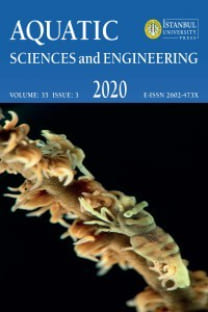Monitoring of Biochemical Effects of Phenol in the Carp (Cyprinus carpio) Fry
This study was conducted to investigate the possible side effects of phenol on biochemical param-eters of carp (Cyprinus carpio) fry with an average weight of 0.474±0.04 g. Fishes were treated with 0 (control), 5, 10 and 20 ppm of phenol during 24, 48, 72, and 96 hours. We have tested the effects of phenol on the biochemical profile, i.e., the total protein, lipid and glycogen levels, in the whole body of the carp samples. They showed change as total protein (p<0.05), glycogen (p>0.05) and lipids (p>0.05) content in the whole body. In view of results, the present study reports metabolic dysfunction in response to phenol toxicity in carp.
Keywords:
Cyprinus carpio, Phenol, Glycogen Total protein, Lipid,
___
- 1. Abdel-Hameid, N. A. H. (2007). Physiological and histopathological alterations induced by phenol exposure in Oreochromis aureus juveniles. Turkish Journal of Fisheries and Aquatic Sciences, 7: 131138. google scholar
- 2. Abu Aita, N. A. (2014). Genotoxic, hematological and biochemical changes ınduced by phenol exposure in african Catfish (Clarias gariepinus). Global Veterinaria, 13 (3): 316-324. google scholar
- 3. APHA, 2005. Standard methods of water and wastewater, 21st Edn., American Public Health Association, Washington, DC., ISBN: 0875530478, pp: 2-61. google scholar
- 4. Black, E. C. (1955). Blood levels of haemoglobin and lactic acid in some freshwater fishes following exercise. Journal of the Fisheries Research Board of Canada, 12, 6: 917-929. [CrossRef] google scholar
- 5. Escher , B. I. (2001). Molecular mechanisms in aquatic ecotoxicology: specific and non-specific membrane toxicity. A habilitation thesis, Swiss Federal Institute of Technology, Zurich, Switzerland. google scholar
- 6. Fernandez-Vega, C., Sancho, E., Ferrando, M. D. (2015). Energy reserves mobilization in the yellow eel as herbicide exposure effect. Chemosphere, 135: 94-100. [CrossRef] google scholar
- 7. Folch, J., Lees, M., Stanley, G. H. S. (1957). A simple method for the isolation and purification of total lipides from animal tissues. The Journal of Biological Chemistry, 226: 497-509. [CrossRef] google scholar
- 8. Garg, S., Gupta, R. K., Jain, K. L. (2009). Sublethal effects of heavy metals on biochemical composition and their recovery in Indian major carps. Journal of Hazardous Materials, 163: 1369-1384. [CrossRef] google scholar
- 9. Hori, T. S. F., Avilez, I. M., Inoue, L. K., Moraes, G. (2006). Metabolical changes induced by chronic phenol exposure in matrinxâ Brycon amazonicus (Teleostei: Characidae) juveniles. Comparative Biochemistry and Physiology Part C: Toxicology & Pharmacology, 143: 67-2. [CrossRef] google scholar
- 10. Inyinbor Adejumoke, A., Adebesin Babatunde, O., Abimbola, O., Adelani-Akande, Tabitha, A. (2018). Water pollution: Effects, prevention, and climatic impact. In: Water Challenges of an Urbanizing World; Matjaz, G., Ed.; IntechOpen: Rijeka, Croatia, 33: 33-52. [CrossRef] google scholar
- 11. Joseph, H., Roe, J. M., Bailey, R., Richard, G., John, N. R. (1961). Complete removal of glycogen from tissues by extraction with cold trichchloroacetic acid solution. Journal of Biological Chemistry, 236: 1244-1246. [CrossRef] google scholar
- 12. Khan, G., Kuek, C., Chaudhary, T., Fhoo, C., Hayes, W. (2000). Role of mycorrhzae and phytochelators in heavy metal contaminated land remediation. Chemosphere, 41: 197-207. [CrossRef] google scholar
- 13. Lowry, O. H., Rosenbrough, N. J., Farr, A. L., Randall, R. J. (1951). Protein measurement with the folin phenol reagent. Journal of Biological Chemistry,193: 265-275. [CrossRef] google scholar
- 14. Ma, P., Wang, M. W., Liu, H, Chen, Y. F., Xia, J. (2019). Research on ecotoxicology of microplastics on freshwater aquatic organisms. Environmental Pollutants And Bıoavailability, 31(1):131-137. [CrossRef] google scholar
- 15. Mishra, A., Poddar, A. N. (2013). Haematology of freshwater murrel (Channa punctatus Bloch), exposed to phenolic industrial wastes of the Bhilai Steel plant (Chhattisgarh, India). International Journal of Engineering Science, 4: 1866-1883. google scholar
- 16. Nicholas, V., Carroll, R., Longley, W., Joseph, H. R. (1956). The determination of glycogen in liver and muscle by use of anthron reagent. Journal of Biological Chemistry, 220: 583-593. [CrossRef] google scholar
- 17. Plummer, D. T. (1971). “An introduction to practical biochemistry”. McGraw-Hill Ltd., Maidenhead, England, p.153. google scholar
- 18. Sannadurgappa D, Ravindranath NH and Aladakatti RH. 2007. Toxicity, bioaccumulation and metabolism of phenol in the freshwater fish. J Bas Clin Physiol Pharmacol 18: 65-77. [CrossRef] google scholar
- 19. Stegeman, J. J, Brouwer, M, Richard, T. D. G., Förlin, L, Fowler, B. A., Sanders, B. M., Van, Veld, P. A. (1992). Molecular responses to environmental contamination: enzyme and protein systems as indicators of chemical exposure and effect, in R.J. Huggett, R.A. Kimerly, P.M. Mehrle, Jr., and H.L. Bergman, (Eds.), Biomarkers: biochemical, physiological and histological markers of anthropogenic stress. CRC/Lewis Publishers, Chelsea, MI, 235-335. [CrossRef] google scholar
- 20. Traas, T. P., Van Leeuwen, C. J. (2007). Ecotoxicological effects. In C. J. van Leeuwen & T. G. Vermeire, eds. Risk assessment of Chemicals - An introduction. Springer, pp. 281-356. [CrossRef] google scholar
- 21. Zaki MS, Fawzi OM, Shalaby SI (2011). Phenol toxicity affecting hematological changes in Cat Fish (Clarius lazera). Life Science Journal, 8(2):244-248. google scholar
- Yayın Aralığı: Yılda 4 Sayı
- Başlangıç: 1987
- Yayıncı: İstanbul Üniversitesi
Sayıdaki Diğer Makaleler
Tevfik CEYHAN, Zafer TOSUNOĞLU
Neslihan ŞENER, Zeliha DEMİREL, Esra İMAMOĞLU, Meltem DALAY
Sanzib Kumar BARMAN, Helena KHATOON, Mohammad Redwanur RAHMAN, Sabuj Kanti MAZUMDER, Shanur HASAN
Melek İŞİNİBİLİR, Esin YÜKSEL, Ezgi TÜRKERİ, Onur DOĞAN, Firdes Saadet KARAKULAK, Uğur UZER, Cem DALYAN, Giulia FURFARO, Stefano PİRAİNO
Sabuj Kanti MAZUMDER, Mohammad Abdus SALAM, Md. Arifur Rahman KHAN, Sarker Mohammed IBRAHIM KHALIL, Md. Tawheed HASAN
Seher DİRİCAN, Aydın KALELİ, Elif YILMAZ, Ali ÖZER, Hayri DAYIOĞLU
